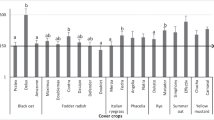Abstract
A highly susceptible cowpea,Vigna sinensis cv. Baladi plants were tested as trap plants for eitherMeloidogyne javanica orRotylenchulus reniformis under greenhouse conditions. The plants were gathered by cutting them above the surface of the soil or by uprooting them, 1/2, 1, 3, 6, 12, 24, 36 and 48 days after nematode inoculation. Both of the mentioned nematodes began to mature and lay eggs after the 12th day from their inoculation. Hence, it is advised to pull up cowpea plants from 3–12 days after nematode inoculation. After planting sunflower,Helianthus annus cv. Miak replacing cowpea, the nematode populations were higher, in most cases, on sunflower plants replacing cutting cowpea than those on sunflower replacing uprooted cowpea. The highest percentages of nematode reduction were 98.55 and 99.57 forM. javanica and 95.09 and 92.90% forR. reniformis on sunflower plants replacing cutting and uprooted cowpea plants after 12 days from nematode inoculation, respectively.M. javanica andR. reniformis decreased the length and weight of sunflower plants as affected by planting time and method of cowpea harvest. This method of nematode control is cheaper, easy and pollution free.
Similar content being viewed by others
References
Franklin, M. T., 1949: A cotton-blue lactophenol technique for mounting plant parasitic nematodes. J. Helminthol.23, 175–178.
Hafez, S. L., 1994: The impact of different green manure crops growing in sugarbeet rotation on sugarbeet cyst nematode and sugarbeet yields. Proceed. of the Second Intern. Symp. of the Afro-Asian Soc. of Nematol., Menoufyia Univ., Shebin El-Kom, Egypt. (Dec., 18–22, 1994) p. 37.
Jenkins, W. R.;Taylor, J. V., 1967: Biological control of nematodes. In: Plant Nematology. Edited byJenkins, W. R. andTaylor J. V. The Univ. of North Carolina Press, Chapel Hill, p. 234.
Patel, Y. C.;Patel, D. J.;Shukla, Y. M., 1987: Biochemical changes due to root-knot nematodes trapping in castor root. Intern. Nematol. Network Newsl.4, 3–4.
Shaffiee, F.; El-Sherif, M., 1979: Biological methods. In: Plant Nematology. Edited byShafiee, F. andEl-Sherif, M. Cairo Univ. Press, Cairo, pp. 219–220. (In arabic).
Author information
Authors and Affiliations
Rights and permissions
About this article
Cite this article
Amin, W.A., Youssef, M.M.A. Host status effect of cowpea and sunflower on the populations ofMeloidogyne javanica andRotylenchulus reniformis . Anz. Schadlingskde., Pflanzenschutz, Umweltschutz 70, 75–76 (1997). https://doi.org/10.1007/BF02039132
Issue Date:
DOI: https://doi.org/10.1007/BF02039132




